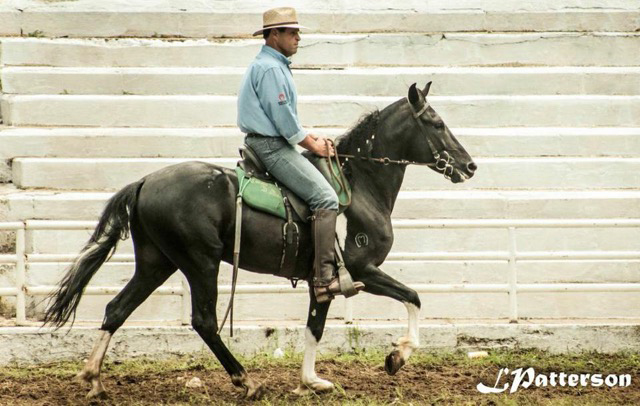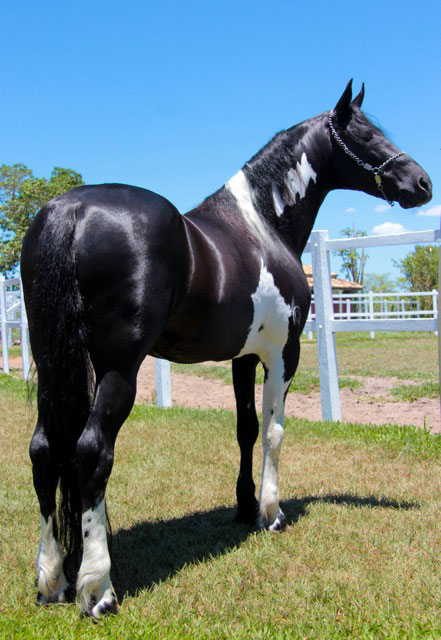
by Patricia N. Saffran
Tobiano is a striking large white spotted coat pattern. Also called pinto, meaning painted in Spanish, the pattern is very old. Tobiano was one of the horse colors to come out of the expansion of coat colors during the Bronze Age in the Eurasian Steppe. Horses had been black or bay/dun, and then at this time, they started to appear in a variety of colors. This period was when some scientists believe that horses were domesticated, or alternatively, it was when horse domestication spread to Europe and Asia. Natural selection is a possible reason for the proliferation of color coats.
The name tobiano comes from the 1800s in Brazil. The question is how did pintos in Brazil come to be known as tobiano? Most sources offer cockeyed and incomplete explanations. The genotype for Tobiano (TO) color remained a mystery until it was discovered in 2007.
Samantha A. Brooks, PhD, Assistant Professor of Equine Physiology, Dept. of Animal Sciences, University of Florida, Gainesville, Brooks, who discovered the Sabino 1 genotype (SB1) variant (a white patterning), also worked on the Tobiano genotype. She discovered that the Tobiano gene is governed by a large chromosomal inversion on chromosome 3 near the KIT gene (responsible for white patterning). This inversion is only found in Tobiano horses, and it occurred around 3000 BC, at the time of the proliferation of horse colors.
The high colored Tobiano horses owe their name to Brazilian Brigadier Rafael Tobias de Aguiar (October 4, 1794 — October 7, 1857) who was a politician and military officer, from Sorocaba, São Paulo. De Aguiar led a checkered existence.
Brigadier de Aguiar was one of the São Paulo Liberal Revolution leaders, who in 1842 rebelled against Conservative forces of the early rule of Emperor Dom Pedro II (later known as a model of Republicanism, for being against slavery, and for education). Curiously, before the battle, de Aguiar married Dom Pedro I’s former mistress. When the rebellion was defeated, in retreat de Aguiar led his army and cavalry of pinto horses across the area known as the Pampas, which in Brazil is the southern most state, Rio Grande do Sul. There they joined yet another rebellion against imperial forces, the Ragamuffin (Farrapos) War, named for the Gauchos’ leather fringed clothing. Six months later, de Aguiar was finally arrested, and sent to Fortaleza da Laje prison further north in Rio de Janeiro (state). The detained de Aguiar, and the remains of his cavalry, very likely rode back north on their gaited pinto horses. Later, he was amnestied and released.

De Aguiar’s gorgeous spotted cavalry horses were gaited to be comfortable for long distance riding. They became well-known as Pampa horses or Tobias’ horses, which was turned into Tobiano. Laura Patterson Rosa, DVM, Ph.D. Student, Brooks Equine Genetics Lab, Department of Animal Sciences, University of Florida, Gainesville, explains, “Although there is no record that de Aguiar was a horse breeder, in Fundação e Evolução das Estâncias Serranas by Aristides Gomes, 1966, the author mentions that Brigadier Tobias de Aguiar gifted some stallions from his cavalry to his friend, Dr. Antonio Gomes Pinheiro Machado, who was a judge living in Rio Grande do Sul. There were no tobiano pattern horses in the south of Brazil prior to the Brigadier’s arrival. These pinto horses were then bred, and disseminated, after the Brigadier’s gift. They became known as Tobiano, in allusion to the celebrated patriot, de Aguiar.
“On the cavalry’s ride north from the southern states of Brazil, while de Aguiar was under arrest, was when their horses’ pinto coat color became widely known to other Brazilian regions. The horses were called ‘Pampa’ — the nickname of Rio Grande do Sul’s prairies, the Pampas. The word Pampa comes from a South American native language (Quichua), and simply means prairies.” Tobiano became the name for pinto horses in the south of Brazil and Pampa was their name in the north.

The fame of these colored horses spread across South America and eventually to North America. Today, tobiano coat color is found in many breeds, and these horses are prized for their beauty.
De Aguiar’s name lives on in another area. In 1831, he had founded a militia, originally known as the São Paulo Municipal Imperial Guard, which included a cavalry unit of thirty riders. One hundred years later, in 1932, it was reestablished as special forces of the São Paulo Military Police to quiet civil unrest. Known as Rondas Ostenstivas (Ostensive Rounds) Tobias de Aguiar, or ROTA, now has over 100,000 personnel around the state. ROTA still has cavalry, a mounted band, as well as a riding school, and they even offer therapeutic riding. The cavalry continues to work as police. At times ROTA has been known to be oppressive (they have been compared to the US SWAT teams).
It is incongruous that de Aguiar is considered the patron of the São Paulo Military Police. While de Aguiar formed the militia with cavalry to act as police to keep order, he later became an agent for social change. He challenged autocratic rule while riding around on his gaited pinto horses.

































